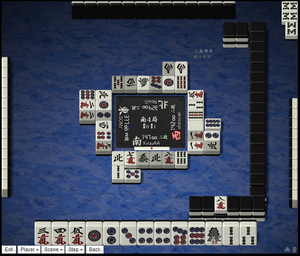Suji

|

|

|

|

|

|

|

|

|
Suji 「筋」 is the principle of utilizing the "mahjong intervals". This applies to the numbered suits: souzu, pinzu, and manzu. While these three suits are numbered 1 through 9, the numbers may be arranged in a square fashion to determine the "intervals". The purpose is to deduce and/or determine tiles waiting via open waits.
Intervals
The intervals for suji apply to any of the numbered suits. Nine types of intervals are available. For this example, pinzu are used:
| Middle tiles | Waiting for | Interval name | Completion |
|---|---|---|---|
| Two-sided, or Ryanmen | |||
| 1-4, or Iisuu 「イースー」 | |||
| 2-5, or Ryanuu 「リャンウー」 | |||
| 3-6, or Sabukou 「サブロー」 | |||
| 4-7, or Suuchii 「スーチー」 | |||
| 5-8, or Uubbaa 「ウッパー」 | |||
| 6-9, or Roukyuu 「ローキュー」 | |||
| Three-sided, or Ryanmenten | |||
| 1-4-7, or Iisuuchii 「イースーチー」 | OR | ||
| 2-5-8, or Ryanuubaa 「リャンウッパー」 | OR | ||
| 3-6-9, or Sabukoukyuu 「サブローキュー」 | OR | ||
The left column shows tiles that may appear in a player's hand, while the middle tiles show the tiles needed in order to complete a needed tile group. The recognition makes it helpful to identify waiting tiles by association. In the case of these waiting patterns, if a hand is waiting for one tile, it is likely waiting for another tile in the interval. Even if these take on Japanese names, they are simply the numbers. Finally, the end result shows the the waiting tiles as the completed tile grouping(s).
Defense
Defending using suji essentially presumes a player to be utilizing either the wait pattern of ryanmen, ryanmenten, nobetan, sanmentan, or some other variation. Under the rule of furiten, if a player discarded a waiting tile, then the player's ability to call "ron" is disabled. Therefore, certain tile discards may rule out certain mahjong intervals.
Of course, one should not be necessarily dependent on these intervals alone, as some waiting patterns are immune to suji.
Offense

The strategy of suji may be used offensively. By utilizing suji in reverse, a player may use a tile within an "octave" to lure out a winning tile along the same "octave". This is commonly known as the "suji trap".
External links
- Suji in Japanese Wikipedia
| |||||||||||